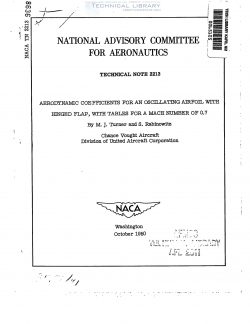naca-tn-2213
- Version
- 529 Downloads
- 1.69 MB File Size
- 1 File Count
- December 14, 2016 Create Date
- June 4, 2019 Last Updated
National Advisory Committee for Aeronautics, Technical Notes - Aerodynamic Coefficients for an Oscillating Airfoil with Hinged Flap, with Tables for a Mach Number of 0.7

Dietze's method for the solution of Possio's integral equation has
been used to determine the» chordwise distribution of lift on an oscil—
lating airfoil with simple hinged flap in two-dimensional compressible
flow (subsonic). The results of these calculations have been used to
prepare tables of aerodynamic coefficients for lift, pitching moment
(referred to quarter-chord point), and flap hinge moment for a Mach
number of 0.7; the motions considered are vertical translation, airfoil
rotation about the quarter-chord point, and rotation of the flap about
its hinge line.
Aerodynamic coefficients are tabulated for 11- values of TR (ratio
of flap chord to total chord) and for 12 values of reduced frequency (or,
covering the range from 0 to 0.7. Results are given for one value of
Mach number, M = 0.7. Data of this kind have already been presented
by Dietze for one value of.the ratio of flap chord to total chord,
TR = 0.15 3 these results have been checked independently, and calcula-
tions have been carried out for three additional values, TR = 0.21},
0.33, and 0.12. Certain auxiliary parameters, which will be needed in
any further calculations of this type, are presented for future reference.
The fundamental integral equation for the pressure distribution on
an oscillating thin airfoil moving at subsonic speed has been derived
by Possio in reference 1. Collocation procedures have been used by
Possio, Frazer and Skan, and others to obtain lift and moment on an
oscillating flat plate. An important contribution has been made by
Dietze (see references 2 and 3), who has developed an iterative procedure
for numerical solution of Possio' s integral equation. This procedure is
particularly well adapted to the calculation of aerodynamic loading on
an oscillating airfoil with hinged flap.
It has been pointed out correctly by Karp and Neil (reference 11-,
p. 11) that Dietze‘s procedure does not properly account for the loga-
rithmic singularity in pressure distribution at the flap hinge. However,
for applications in flutter analysis the principal objective is to deter-
mine resultant lift and moments rather than pressure distribution. Mathe-
matically exact solutions in closed form are available for the stationary
thin airfoil with deflected flap , and it is found that lift and moments
obtained by Dietze’s iterative procedure are in excellent agre-ent with
theoretically exact values. There is good reason to expect that equally
satisfactory results will be obtained for the airfoil with oscillating
flap. The existence of the singularity in pressure distribution is a
consequence of the sharp corner in the idealized, broken-line profile,
and of the associated discontinuity in downwash velocity at the flap
hinge. The introduction of a finite cosine series for the downwash is
in effect equivalent to a slight modification of the idealized profile
by rounding off the corner at the flap hinge.
| File | Action |
|---|---|
| naca-tn-2213 Aerodynamic Coefficients for an Oscillating Airfoil with Hinged Flap, with Tables for a Mach Number of 0.7.pdf | Download |
Comment On This Post